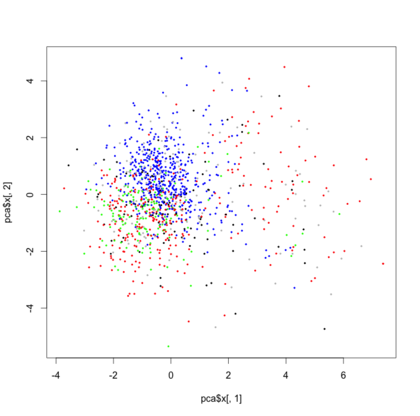Posts by David Hood
Last ←Newer Page 1 2 3 4 5 Older→ First
-
Polity: Meet the middle, in reply to
I used grey for everyone else because they were small parties, there are irregularities in the variable labels of who people voted for so it was not always clear in the case of the minor parties what people had actually voted for, and I didn't want to overload the graph with colours.
-
Polity: Meet the middle, in reply to
This is my point. Actual voter position in a multiparty democracy is less a line through two points and more Jackson Pollock.
-

I've taken all of columns 162 to 170 (the where do you think parties fall on a left right spectrum and where do you fall) and run a PCA to extract the two most significant factors. I've also coloured it by who they voted for.
Observations:
1 - National voters have a pretty coherent view of where parties (and themselves) are on a left right spectrum. It is less important to other voters as there is less clustering.
2 - I invite anyone who believes in a centre and a one dimensional scale to find it in this data of voter world views.intery <- dataset[,c(235,162:170)]
intery$jpartyvote <- applylabels(intery$jpartyvote)
intery[2:ncol(intery)] <- apply(intery[2:ncol(intery)],2, as.numeric)
for(i in 2:ncol(intery)){
x <- intery[,i]
x[x == 99] <- NA
intery[,i] <- x
}
intery <- intery[(complete.cases(intery)),]
fillcol <- rep("grey", nrow(intery))
fillcol[intery$jpartyvote == "Labour"] <- "red"
fillcol[intery$jpartyvote == "National"] <- "blue"
fillcol[intery$jpartyvote == "Green"] <- "green"
fillcol[intery$jpartyvote == "NZ First"] <- "black"
pca <- prcomp(intery[2:(ncol(intery))], scale = TRUE)
plot(pca$x[,1], pca$x[,2], col=fillcol, cex=0.3, pch=19) -
I note there are more people who said they "Didn't manage to vote" and "voted Labour" than those that said they "Didn't manage to vote" and "voted National", but there were more people who "Chose not to vote" and "voted National" than "Chose not to vote" and "voted Labour"
Conclusion: Don't read too much into the detail.
-
Just a technical note for the benefit of people playing with the NZES, as a SPSS save file I can read it into R with the haven package, but because there are missing entries in the values labels, I am being really cautious about using those labels. This code might be useful to others:
library(haven)
ds <- read_spss(file.choose())
intery <- dataset[,c(234,235,269)]applyValLabels <- function(column){
knownvalues <- attributes(column)$value.labels
valuelabels <- names(knownvalues)
lookup <- data.frame(column = as.character(knownvalues), valuelabels, stringsAsFactors = FALSE)
target <- data.frame(column = as.character(column), index=1:length(column), stringsAsFactors = FALSE)
combined <- merge(target, lookup, all.x=TRUE)
combined <- combined[order(combined$index),]
output <- as.character(column)
output[!(is.na(combined$valuelabels))] <- combined$valuelabels[!(is.na(combined$valuelabels))]
return(output)
}
jpartyvote <- applyValLabels(intery$jpartyvote)
table(jpartyvote, intery$jpartyvote) -
-
Polity: Meet the middle, in reply to
Yes, the swinging voter can jump off the swing
To further complicate it, I think it would be a mistake to treat non-voting as one destination. As measured by the data, a ACT supporting non-voter may be in a very different voting space to a Internet/Mana one.
-
Polity: Meet the middle, in reply to
But we know that support for Labour and National has traditionally had an urban/ rural divide. So it is not geographically even.
Also, for the NZES 2014 survey data, of the 2835 surveyed people. 90 fewer voted for Labour this time than last time (same people in the survey casting their mind back to the last election) and 53 fewer voted for National. This is not a closed system where the votes move between in a line between parties. It is an open system with people moving into did not vote land. Since Labour seemed to have shed more votes to the Apathy party, I think there is more scope for actually inspiring people to return, since as previous Labour voters they can be assumed to have some Labour sympathies.
I don't think it is easy to use as a reservoir, precisely because shedding votes means a blind-spot to the constituency (or they would be supportive) and blind spots are hard to see. I just think there is more scope for Labour than National. -
Polity: Meet the middle, in reply to
I seem to recall, in an I’m away from my computer and can’t check the numbers, that electorates that elected Labour MPs had a generally lower turnout than electorates that elected National MPs. I would say this is evidence that turnout is associated with party support. I would further suggest that this means Labour have more opportunity to win by inspiring people to the left to actually support them, whereas National have to place more emphasis on get voters from the space between Labour and National.
-
Polity: Meet the middle, in reply to
It is pretty clear turnout is strongly conditioned by age and ethnicity
And there is evidence that party support is in age bands
http://liberation.typepad.com/liberation/2008/05/political-par-9.html
And ethnicity
http://liberation.typepad.com/liberation/2008/05/political-par-7.html
So if anything it needs some evidence that the voting population is different to the electorate population to make the 1/3 1/3 1/3 argument.


